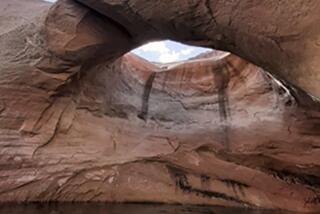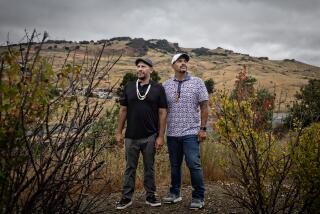A Civilization Revived at Wupatki Monument
FLAGSTAFF, Ariz. — When the Wupatki civilization was at its peak in the 12th Century, it could have been viewed as a prehistoric Phoenix, like the mythical bird, rising from the ashes of its predecessors.
Indeed, the story of the Wupatki is one of cataclysmic destruction followed by rebirth and, finally, extinction.
What remains of the civilization is the Wupatki National Monument, a little-known treasure in north-central Arizona.
Wupatki is Hopi for “tall house,” an accurate, if not particularly inspiring description of the monument’s crown jewel--an 800-year-old, three-story pueblo that still contains remnants of all three levels.
Elsewhere within the 56-square-mile monument are scores of other ruins--the National Park Service is still counting them--and 1,000 to 2,000 other archeological sites.
Archeological evidence indicates that members of a prehistoric people known as the Sinagua (Spanish for “without water”) had settled the Wupatki region as early as AD 700. They dwelled in primitive pit houses, and dry-farmed crops on the high plateau east of Arizona’s 12,600-foot San Francisco Peaks.
Unfortunately for them, the San Francisco Peaks region is volcano country, and in the winter of 1264-65 (the date is known precisely because of tree-ring dating), a new volcano erupted in the midst of their cornfields, burying fields and villages in a rain of cinders and, eventually, under lava flows.
The Sinagua had no choice but to flee. Two or three generations later, however, conditions had settled down enough that the region was again habitable, and 20 miles northeast of their original home, the Sinagua found that the dusting of cinders was thin enough to allow crops to be planted in the underlying soil but thick enough to retain sufficient moisture to allow farming in a land that today receives only seven to nine inches of rain per year. During the peak of the Wupatki civilization, however, the climate may have been slightly damper.
Archeologists disagree over the causes of what happened next, but one of the most appealing theories is that the farming discoveries resulted in a prehistoric land rush, with the Sinagua being forced to share their newfound bounty with at least four other civilizations, including the Anasazi of northeastern Arizona, and the Hohokam of the lowland deserts to the south.
Whatever the exact cause, at its peak the territory now included in the monument became home to perhaps 3,000 people, far more than now dwell within miles of it. Although the pueblos were often built on low, cliff-lined hilltops that look like natural fortresses, it appears to have been a peaceful civilization.
The civilization that flourished in Wupatki lasted only 100 years, but it had an unusually cosmopolitan aura, blending aspects of the various cultures that went into it.
Archeologists have discovered more than 125 pottery styles, an indicator of the depth and diversity of the Wupatki culture.
In addition, Wupatki appears to have been something of a melting pot for the great civilizations of the Southwest.
From the Anasazi, it appears to have borrowed the use of ceremonial pits known as kivas, although the kiva at the Wupatki ruin looks more like a large outdoor amphitheater than the circular, roofed pits built by the Anasazi at such places as Mesa Verde.
From the Hohokam and the ancient civilizations of Mexico, the Wupatki also adopted the use of circular ball courts, where a game whose rules are now lost was played using a rubber ball and a hoop. The reconstructed court at Wupatki represents one of the most northerly examples ever located.
The Wupatki culture disbanded in approximately 1225. Possible causes include exhaustion of the overused soils and the impact of a drought that began in 1215. One clan of modern-day Hopis claims the Wupatki people as its ancestors.
The ruins of Wupatki National Monument are either easily accessible or completely off limits, and most people will find that a visit to the monument and nearby Sunset Crater National Monument can be conducted in a relaxing half-day.
Some of the highlights:
--Wupatki Ruin: This is the central attraction of the monument and site of the visitor center and museum, where displays and a movie introduce visitors to the monument and the Wupatki culture. Behind the visitor center, an easy, self-guided walking tour circles the ruin, which in its heyday housed an estimated 300 people.
Nearby, the trail leads to the amphitheater and the reconstructed ball court. Visitors may stand at the mouth of a small hole in the ground known as a blowhole, which, when atmospheric conditions are right, inhales or exhales a stream of air into an underground labyrinth consisting of miles of narrow fissures.
Unlike many of the monument’s other ruins, the Wupatki pueblo was built in a sheltered depression, rather than on a hilltop. Its structure also is unusual because it surrounds a large sandstone rock outcrop, which served as the back wall to many of its rooms.
--Wukoki Ruin: “Wukoki” is Hopi for “big and wide house.” This pueblo had only three to five rooms, but is still impressive, partly because it had a three-story tower and partly for its location, which offers a sweeping view toward the lowlands of the Painted Desert to the northeast.
Because it lies at the end of a three-mile, dead-end road (beginning a quarter-mile from the visitor center), it is less frequently visited than the main ruin at Wupatki and has the further advantage of being out of earshot of the monument’s main road. It is a good place to visit at sunset, when the distant desert turns to haze and it is easy to imagine that life has not changed since the pueblo was last occupied more than 750 years ago.
--Citadel Ruin: The Citadel is a 50-room pueblo built on top of a prominent rocky hilltop. It once stood two stories high, but little is left but rubble.
A paved, self-guided trail leads to the top, where it is possible to spot 10 other nearby ruins. They are easy to find because many are built of reddish sandstone set atop outcrops of darker rock.
At the base of the Citadel, a few feet from the parking lot, lies the 13-room Nalakihu Ruin, whose name means “house standing outside the village.” Like the Citadel, it was once two stories high, but has been reduced to little more than foundations.
--Lomaki Ruin: The only other ruin open to the public is Lomaki (Hopi for “beautiful house”). Perched on the edge of a three-quarter-mile-long fissure in the underlying bedrock, Lomaki is small but is one of the best-preserved ruins in the monument. It has two storiesand contains nine rooms. The quarter-mile trail leading to it passes other small ruins.
--Crack-in-Rock Ruin: In general, backpacking and hiking are not permitted at the national monument. The one exception is a ranger-guided backpacking trip to Crack-in-Rock Ruin.
In addition to offering the only opportunity for camping in the national monument, the Crack-in-Rock trip also gives participants a chance to explore a collection of rock etchings at the base of the mesa.
There was a fee of $10 for the trip this year, and applications should be made well in advance. Each hike is limited to 25 people and is filled by a combination of lottery and first-come, first-served methods. The hike is offered only on weekends in April and October, and covers 14 miles.
GUIDEBOOK: Arizona Monuments
Getting there: Wupatki and Sunset Crater national monuments are east of Arizona 89, north of Flagstaff. A paved, 36-mile road offers access to both, branching off Highway 89 at a marked turnoff 12 miles north of Flagstaff and returning to the highway at another marked intersection approximately 20 miles north of that. Admission to both monuments is $3 per car.
When to go: The road is open 24 hours a day. Both visitor centers are open year-round, except Christmas and New Year’s Day, from 8 a.m. to 5 p.m. Climate within the monuments varies with elevation, which, along the road, ranges from 7,500 at Sunset Crater to 4,900 feet at the Wupatki visitor center. Winters can be cold.
Where to stay: There is no lodging or food at either monument. Complete visitor facilities are in Flagstaff. Call (800) 842-7293.
Although there are no campgrounds at either monument, there is a 44-site national forest campground near the Sunset Crater visitor center. Facilities include water and restrooms, but no showers. The fee is $7, and the campground is generally open from May through mid-October.
For more information: Call the Wupatki visitor center at (602) 527-7040. For information on Sunset Crater, phone (602) 527-7042.
More to Read
Sign up for Essential California
The most important California stories and recommendations in your inbox every morning.
You may occasionally receive promotional content from the Los Angeles Times.










